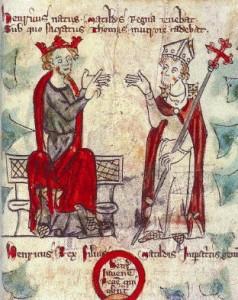Out of the thirty four years of his reign (1154- 1189), Henry II spent twenty-one on the Continent. Socially and culturally, England was a backwater compared with the continental parts of the Angevin dominion.
Henry introduced several major reforms to England. Prior to 1166 trial by ordeal was a common way of determining guilt or innocence in criminal cases. Under this system, an accused person might have to pick up a red hot bar of iron, or pluck a stone out of a boiling cauldron. If their hand had begun to heal after three days they were considered to have God on their side, affirming their innocence. Henry gradually replaced this rather painful system with a jury of 12 men. He also introduced the first personal property tax. At the same time he forced Wales to at least nominally acknowledge the sovereignty of the English crown.
Henry was married to the forceful Eleanor of Aquitaine, the divorced wife of Louis VII of France, and in their squabbling she turned their sons Richard, John, and Geoffrey against him. The “Devil’s Brood” intrigued, fought, and rebelled against their father. By 1174 she was influencing the ‘young King Henry’ as well (see below). In the end, the crown went to Richard, while John “Lackland” received nothing, until 1185, when he was offered Ireland. Geoffrey received even less; He died before his father.
Henry desired to be absolute ruler of his dominions, both Church and State, and could find precedents in the traditions of the throne when he planned to do away with the special privileges of the English clergy, which he regarded as fetters on his authority. As Henry’s chancellor since 1155, Becket enforced the king’s traditional medieval land tax that was exacted from all landowners, including the churches and bishoprics, assisted by a force of 800 knights. This created both a hardship and a resentment of Becket among the English churchmen. To further implicate Becket as a secular man, he appeared an accomplished and extravagant courtier and a cheerful companion to the king’s pleasures. Thomas was devoted to Henry’s interests with a firm and yet diplomatic thoroughness.
It is not for his political successes that Henry is best remembered, but for his role in the murder of Thomas a Becket. In June 1162, Becket had been consecrated archbishop of Canterbury. In the eyes of many contemporaries, Becket did not deserve the highest ecclesiastical post in the land. Despite his clerical education, his appointment was without precedent (he was a secular cleric not monastic)..
Henry assumed that his friend would be sympathetic to the royal cause in the escalating battle between church and state. From being Henry’s closest supporter, de facto England’s chief governor whilst Henry was absent, once archbishop, he went out of his way to oppose his king. Did Thomas undergo the complete change of character often described? He was ostentatiously severe in his observance of church law. As reported after his death, he wore a penitential hair shirt under his vestments, and had his underlings flog him frequently. More importantly, he opposed Henry over the question of the supremacy of ecclesiastical courts, and relinquished the position of chancellor.
In the mid-twelfth century, church-state relations were a potential political minefield, which were often ignored by practical men, secular or clerical, but the fundamental issues centered around power and authority, and this quickly became the chief quarrel between them.
At that time anyone in orders could only be tried in church courts. In practice, the number of clerics was huge, including several levels of lay priests and clerks. Henry, anxious to assert the power of royal justice, claimed that the “criminous clerks” should be tried in royal courts, resenting the way in which clerks who committed crimes could minimise their punishments by claiming trial in an ecclesiastical court. Such outrages were well documented, for example the case of Philip of Brois, an acquitted murderer, or the Worcestershire rape and subsequent murder of the injured girl’s father. The obvious solution was for the offenders to be de-frocked and handed over to the lay courts. Becket refused to agree.
The archbishop fled to France after defying Henry, and reneging on the agreement known as ‘The Constitutions of Clarendon’. They eventually were reconciled with the aid of the pope, and Becket returned. He immediately infuriated Henry by excommunicating those bishops who had prudently supported the king during his exile, later including those in favour of the coronation of Prince Henry in 1170. Henry flew into one of his famous rages when he refused to relent. Four knights, perhaps seeking favour with the king, allegedly responded to the immortal words: ‘Will no one rid me of this meddlesome priest’? by journeying to Canterbury and killed Becket within the Cathedral, on 29 December 1170. Becket’s contemporary biographer, William fitzStephen, put it this way: ‘Thus in death, and by the manner of it, Archbishop Thomas gained all that he had striven for in life, and perhaps more than he had hoped for or expected to gain.’
In the usual account, Henry, full of remorse, did penance imposed by the pope. He also gave way for the moment on the question of court authority. This display has all the appearance of a political reconciliation with the pope and his own people. He walked to Canterbury Cathedral in sackcloth and ashes and allowed himself to be flogged by the monks there. This took place in 1174, why the delay? How were the four knights directly responsible, Reginald FitzUrse, William de Tracy, Hugh de Morville and Richard le Breton punished? After the murder, they made for Knaresborough Castle, Yorkshire, where they remained untouched for a year. Eventually, they were ‘sentenced’ by the pope to a crusade for the Holy Land. In addition, many of those clerics hostile to Becket before his death, such as Geoffrey Ridel and Richard of Ilchester, gained prestige thereafter.
The young King Henry, crowned by the Archbishop of York in June 1170, ruled from Woodstock, England until his death in 1183, and opposed by Becket, who can only have seen him as a political rival. Seldom remembered is his civil war against his father in 1174.
In popular memory, Becket came to symbolize resistance to the Angevin state, and Becket’s martyrdom did Canterbury Cathedral no harm at all. In a very short time miraculous cures began to be reported at his tomb. The old Cathedral burned down in 1174, and it was the growing popularity of Becket’s shrine as a place of pilgrimage, immortalized by Chaucer, that paid for the rebuilding. Much of the magnificent Cathedral that we see today was built on the proceeds of gifts and the sale of “Canterbury water” (water tinged pink with drops of ‘saint’s’ blood) at the shrine during the next few hundred years. Canterbury became one of the most visited pilgrimage sites in western Christendom. Interestingly, this shrine was an early target of the Reformation iconoclasts, who destroyed it in 1538.
References
A L Poole (1951) Oxford History of England: From Domesday Book to Magna Carta
W L Warren (1973) Henry II
W fitzStephen The Life Of Thomas Becket (Folio Society 1961)
S Schama (2000) A History of Britain